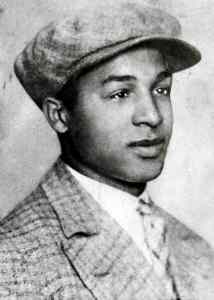German actor, dancer and activist

Hilarius Gilges (28 April 1909 – 20 June 1933) was a German actor, dancer and communist political activist. He was murdered at the age of 24 by the Nazi party.
Life
Hilarius Gilges was one of the few black Germans born in the country before the First World War. His mother Maria Stüttgen was a textile worker in Düsseldorf; the origin of his biological father is not known for certain. Maria married Franz Peter Gilges in 1915, giving the boy the family name Gilges.
Gilges grew up in the working class milieu of Düsseldorf and joined German Communist Youth in about 1925 or 1926. He became an amateur actor with the communist agitprop theatre group "Nordwest ran" directed by Wolfgang Langhoff. His radical politics led in 1931 to his arrest and sentencing to one year in prison. After his release in 1932 he continued as an active communist agitator.
Gilges married Katharina Hubertine Laatsch (born Vogels) and fathered two children.
Death
In early 1933, after the Nazis seized power, he attempted to go into hiding, but his visibility due to his skin color made this difficult. In June 1933, he was arrested in his apartment in the city's Altstadt district (Old Town) district of Düsseldorf. His body was found under a bridge the next day. The perpetrators are believed to have been six members of the Gestapo and SS, but even after the end of Nazi rule, were not tried in court.
His widow and two children survived the Nazi period, probably because they were helped by neighbors in the Altstadt. In 1949 they were given a lump sum compensation of 12,000 Deutschmark as restitution.
Commemorations
On 23 December 2003 the city of Düsseldorf named a plaza after Hilarius Gilges, in the vicinity of the Düsseldorf Academy of Arts. In 1988 a plaque had been already placed at the approximate site of the murder. The plaque was commissioned by the Düsseldorf city museum and designed by the local artist Hannelore Köhler. It shows a relief profile of Gilges.
References
- Clarence Lusane: The Historical Experiences of Afro-Germans, European Blacks, Africans, and African Americans in the Nazi Era. Routledge, London 2002, ISBN 0-415-93121-5,
- Lothar Pützstück: „AfrikanerInnen in Deutschland und schwarze Deutsche – Geschichte und Gegenwart. Beiträge zur gleichnamigen Konferenz vom 13.-15. Juni 2003 im NS-Dokumentationszentrum Köln“. In: Marianne Bechhhaus-Gerst, Reinhard Klein-Arendt (Hrsg.): Begegnungen. Geschichte und Gegenwart der afriknisch-europäischen Begegnung. LIT Verlag, Münster 2004.
Notes
- Aitken, Robbie; Rosenhaft, Eve (26 September 2013). Black Germany: The Making and Unmaking of a Diaspora Community, 1884-1960. Cambridge University Press. ISBN 978-1-107-04136-3.
- Nazi Ideology and the Holocaust. United States Holocaust Memorial Museum. 2007. ISBN 978-0-89604-712-9.
- ^ "Todestag des Hilarius Gilges (in german)". Archived from the original on 19 July 2011. Retrieved 8 June 2010.
- Lusane, Clarence (23 November 2004). Hitler's Black Victims: The Historical Experiences of European Blacks, Africans and African Americans During the Nazi Era. Routledge. ISBN 978-1-135-95524-3.
- Museum, United States Holocaust Memorial (1998). The Holocaust and History: The Known, the Unknown, the Disputed, and the Reexamined. Indiana University Press. ISBN 978-0-253-21529-1.
- Fascism, World Committee for the Victims of German (1969). The Reichstag Fire Trial: The Second Brown Book of the Hitler Terror. H. Fertig.
- "Hilarius Gilges - Ein Schwarzer Deutscher Düsseldorfer - Gedenktafel". www.hilarius-gilges.de. Retrieved 12 February 2022.
- Gilroy, Paul (2000). Against Race: Imagining Political Culture Beyond the Color Line. Harvard University Press. ISBN 978-0-674-00096-4.